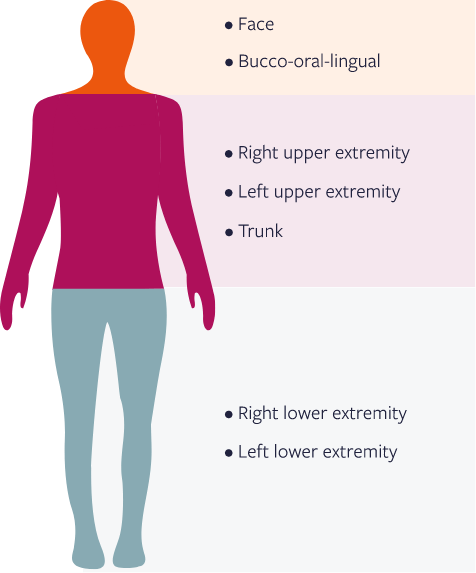Efficacy in adults with Huntington’s disease chorea
SELECT EFFICACY ENDPOINT:
12-week
TMC reduction
2-year
TMC reduction
2-year
GI-C/PGI-C
12-week TMC reduction
12-week TMC reduction
2-year TMC reduction
2-year GI-C/PGI-C
INGREZZA provides rapid and sustained HD chorea control1,2
Reductions seen as early as Week 2 and at all study visits
Mean change in Total Maximal Chorea score over time1,2



STUDY DESIGN
TMC SCALE INFORMATION
|
aP<0.0001. |
|
Baseline is the average of screening and Day –1 assessments; end of treatment is the average of Week 10 and Week 12 assessments. |
|
TMC, Total Maximal Chorea; SEM, standard error of mean; LS mean, least squares mean. |
|
aP<0.0001. |
|
Baseline is the average of screening and Day –1 assessments; end of treatment is the average of Week 10 and Week 12 assessments. |
|
TMC, Total Maximal Chorea; SEM, standard error of mean; LS mean, least squares mean. |
HD chorea control was sustained long-term3
Reductions in TMC score sustained through 2 years
Mean change in Total Maximal Chorea score over time in interim analysis of KINECT-HD2, a long-term, open-label study3



STUDY DESIGN
TMC SCALE INFORMATION
THE ONLY VMAT2 INHIBITOR STUDIED IN PATIENTS WITH HD CHOREA TAKING ANTIPSYCHOTICS3
Physicians and patients see high rates of success, long-term
Percentage of physicians and patients rating overall symptoms of chorea as “very much improved” or “much improved” with INGREZZA at 2 years3,*




STUDY DESIGN
CGI-C/PGI-C INFORMATION
| * | Data from interim analysis of KINECT-HD2, a long-term, open-label study. |
Watch expert perspective videos on INGREZZA
Featuring Steven Lo, MD; Lawrence Elmer, MD, PhD; Bisena Bulica, DO
These videos were sponsored and developed by Neurocrine Biosciences.
The speakers are paid consultants of Neurocrine Biosciences.
About the KINECT-HD pivotal study

Efficacy and safety of INGREZZA in patients
with HD chorea

THERAPEUTIC DOSE FROM DAY 1
The only VMAT2 inhibitor that offers an effective starting dosage you can adjust based on response and tolerability1
EXPLORE DOSINGSEE PATIENT CASES
FROM KINECT-HD
View videos of clinical trial patients with HD chorea treated with INGREZZA
WATCH CASE VIDEOSINGREZZA CLINICAL
SAFETY DATA
INGREZZA was studied across a broad range of patients with HD chorea
VIEW SAFETY PROFILEREFERENCES:
- INGREZZA [package insert]. San Diego, CA: Neurocrine Biosciences, Inc.
- Stimming EF, Claassen DO, Kayson E, et al. Safety and efficacy of valbenazine for the treatment of chorea associated with Huntington’s disease (KINECT-HD): a phase 3, randomised, double-blind, placebo-controlled trial. Lancet Neurol. 2023;22(6):494-504.
- Data on file. Neurocrine Biosciences, Inc.
- Unified Huntington’s Disease Rating Scale: reliability and consistency. Huntington Study Group. Mov Disord. 1996;11(2):136-142.
- Guy W. ECDEU Assessment Manual for Psychopharmacology. Revised 1976. Rockville, MD: National Institute of Mental Health; 1976.








